Comedy, drama, music, sports, news, religious services-radio
programming has, since the 1920s, offered something for everyone for a
few hours each day. WQAT, in Richmond, used the station of a local
amateur to broadcast music from phonograph records and, in 1922, the
World Series. In 1923, WTAR in Norfolk broadcast a two-hour concert,
religious services, and, in 1924, the Democratic National Convention.
In Roanoke, WDBJ aired old-time banjo and fiddle music in 1924 and, by
"coincidence," sold radio parts from its parent company,
Richardson-Wayland.
|
| |
|
 |
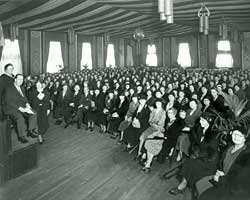 |
|
Storefront remote broadcast (National
Radio Month) |
The Sunshine Hour starred Holland R.
Wilkinson, the singing evangelist, and was broadcast from 1927 to
1954.
|
| |
In 1926, a new form of program hit the airwaves to great success.
Amos 'n' Andy, originally known as Sam 'n' Henry, aired its first
program on January 12, 1926 on WGN in Chicago. The show was an instant
hit. When Amos 'n' Andy joined NBC in 1929, the sale of radios
skyrocketed and millions of listeners tuned in. Amos 'n' Andy was only
the beginning of the evolution of programming during radio's golden
years of the 1930s and 1940s. Before the advent of television, people
listened to situation comedies (Easy Aces and The Goldbergs), dramas
(The Lone Ranger and The Shadow), adventures (Jack Armstrong, The
All-American Boy), and soap operas (The Hilltop House and The Second
Mrs. Burton). Radio also offered comedy variety shows as The Rudy
Vallee Show, The Fred Allen Show, and The Charlie McCarthy Show with
ventriloquist Edward Bergen and his sidekick Charlie McCarthy. Radio
even broadcast aliens. In 1938, a broadcast announced that Martians
had invaded New York and New Jersey, wreaking havoc and devastation.
Orson Welles directed the radio dramatization known as The War of the
Worlds. Many listeners, however, did not hear the opening credits,
actually believed that Martians were invading, and panicked.
|
| |
|
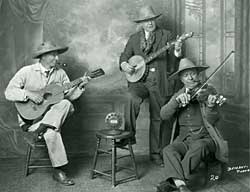 |
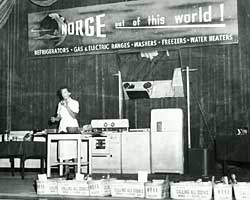 |
|
In the early days, radio stations
used local talent. The Virginia Fiddlers played on WRVA in the 1920s.
Applause memos tracked how far WRVA's signal reached and which
programs were most popular.
Virginia Fiddlers (left to right: Bernard Belvian, John Seay, and W.
C. Gilliam). 1920s. Photograph. |
WRVA experimented with a cooking show
in 1934 when it promised advertisers that, for $100, Miss Belle T.
Abrams would mention their products on her ten-show cooking school.
WRVA later launched Calling All Cooks that offered advise on cooking
and demonstrated the latest in culinary appliances and products.
Calling All Cooks. 1950s. |
| |
As the world became enveloped in the Second World War, broadcast
journalism emerged. People tuned in to listen to Arthur Godfrey,
Edward R. Murrow, Edwin C. Hill, and H. V. Kaltenborn to hear the
latest news. Radio brought into American living rooms Adolf Hitler's
speeches and journalist William L. Shirer's commentary, President
Franklin Delano Roosevelt's address to the U. S. Congress after the
Japanese attack on Pearl Harbor on December 7, 1941, and news of the
invasion on Europe on June 6, 1944.With the arrival of television in the late 1940s, people no longer
listened to their favorite shows; they watched them. Radio remained
popular in areas where television reception was difficult, but, as the
1950s continued and Americans hit the road, they took their radios
with them.
|
| |
|
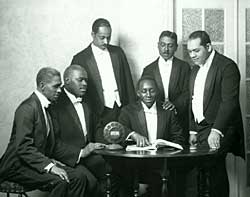
|
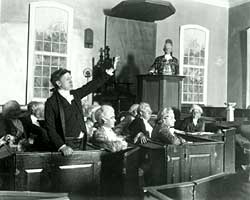
|
|
Joe Matthew's Sabbath Glee Club |
Radio
offered live theater including the reenactment of Patrick Henry's 1775
"Give me liberty or give me death" speech, with Douglas Southall
Freeman as the famous orator. |
|
|
|